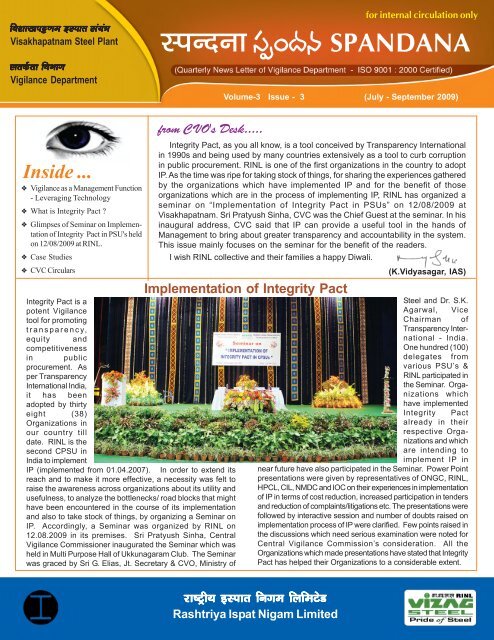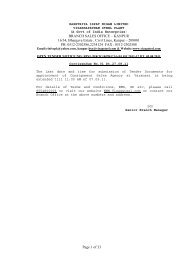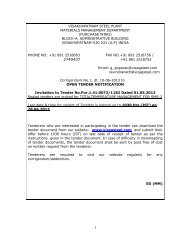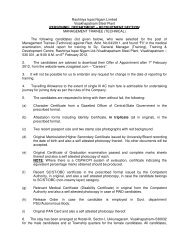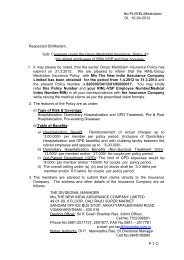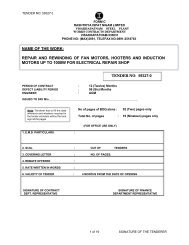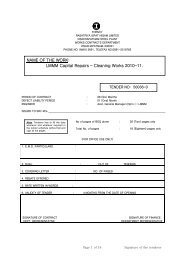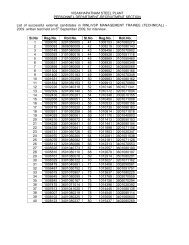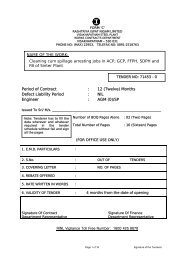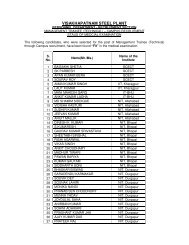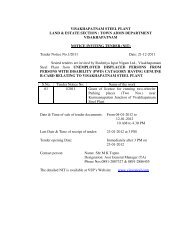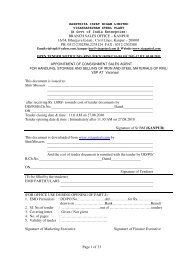Spandana Jul - Vizag Steel
Spandana Jul - Vizag Steel
Spandana Jul - Vizag Steel
You also want an ePaper? Increase the reach of your titles
YUMPU automatically turns print PDFs into web optimized ePapers that Google loves.
uƒΔÁQúcm FÀúÁo ÃÊÆÊfi<br />
Visakhapatnam <strong>Steel</strong> Plant<br />
ÃoN|˛oÁ uƒßÁT<br />
Vigilance Department<br />
for internal circulation only<br />
ÀúãtåÁ ã¨ÊO^Œ# SPANDANA<br />
Volume-3 Issue - 3 (<strong>Jul</strong>y - September 2009)<br />
Inside ...<br />
v Vigilance as a Management Function<br />
- Leveraging Technology<br />
v What is Integrity Pact <br />
v Glimpses of Seminar on Implementation<br />
of Integrity Pact in PSU's held<br />
on 12/08/2009 at RINL.<br />
v Case Studies<br />
v CVC Circulars<br />
from CVO's Desk.....<br />
Integrity Pact is a<br />
potent Vigilance<br />
tool for promoting<br />
transparency,<br />
equity and<br />
competitiveness<br />
in public<br />
procurement. As<br />
per Transparency<br />
International India,<br />
it has been<br />
adopted by thirty<br />
eight (38)<br />
Organizations in<br />
our country till<br />
date. RINL is the<br />
second CPSU in<br />
India to implement<br />
IP (implemented from 01.04.2007). In order to extend its<br />
reach and to make it more effective, a necessity was felt to<br />
raise the awareness across organizations about its utility and<br />
usefulness, to analyze the bottlenecks/ road blocks that might<br />
have been encountered in the course of its implementation<br />
and also to take stock of things, by organizing a Seminar on<br />
IP. Accordingly, a Seminar was organized by RINL on<br />
12.08.2009 in its premises. Sri Pratyush Sinha, Central<br />
Vigilance Commissioner inaugurated the Seminar which was<br />
held in Multi Purpose Hall of Ukkunagaram Club. The Seminar<br />
was graced by Sri G. Elias, Jt. Secretary & CVO, Ministry of<br />
Integrity Pact, as you all know, is a tool conceived by Transparency International<br />
in 1990s and being used by many countries extensively as a tool to curb corruption<br />
in public procurement. RINL is one of the first organizations in the country to adopt<br />
IP. As the time was ripe for taking stock of things, for sharing the experiences gathered<br />
by the organizations which have implemented IP and for the benefit of those<br />
organizations which are in the process of implementing IP, RINL has organized a<br />
seminar on “Implementation of Integrity Pact in PSUs” on 12/08/2009 at<br />
Visakhapatnam. Sri Pratyush Sinha, CVC was the Chief Guest at the seminar. In his<br />
inaugural address, CVC said that IP can provide a useful tool in the hands of<br />
Management to bring about greater transparency and accountability in the system.<br />
This issue mainly focuses on the seminar for the benefit of the readers.<br />
I wish RINL collective and their families a happy Diwali.<br />
(K.Vidyasagar, IAS)<br />
Implementation of Integrity Pact<br />
<strong>Steel</strong> and Dr. S.K.<br />
Agarwal, Vice<br />
Chairman of<br />
Transparency International<br />
- India.<br />
One hundred (100)<br />
delegates from<br />
various PSU’s &<br />
RINL participated in<br />
the Seminar. Organizations<br />
which<br />
have implemented<br />
Integrity Pact<br />
already in their<br />
respective Organizations<br />
and which<br />
are intending to<br />
implement IP in<br />
near future have also participated in the Seminar. Power Point<br />
presentations were given by representatives of ONGC, RINL,<br />
HPCL, CIL, NMDC and IOC on their experiences in implementation<br />
of IP in terms of cost reduction, increased participation in tenders<br />
and reduction of complaints/litigations etc. The presentations were<br />
followed by interactive session and number of doubts raised on<br />
implementation process of IP were clarified. Few points raised in<br />
the discussions which need serious examination were noted for<br />
Central Vigilance Commission’s consideration. All the<br />
Organizations which made presentations have stated that Integrity<br />
Pact has helped their Organizations to a considerable extent.<br />
∫Á…b~yÆ FÀúÁo uåT u¬ubzg<br />
Rashtriya Ispat Nigam Limited
ã¨ÊO^Œ# ÀúãtåÁ<br />
Vigilance as a Management Function - Leveraging Technology<br />
- Sri Balwinder Singh, Addl. Secretary, CVC<br />
Vigilance is not a stand-alone activity. It has to be seen as<br />
part of the overall risk management strategy of an organization<br />
wherein the structures, systems and processes are built in such a<br />
manner so as to prevent leakages which adversely affect productivity<br />
and profitability. A number of organizations both in public and private<br />
sector are re-engineering their processes by leveraging information<br />
technology. It will be in the organizational interest that when they<br />
are reorganizing business processes they should identify the likely<br />
risks like fraud, corruption, other malpractices and build in the required<br />
risk management tools in the new processes. Recently a write-up<br />
has appeared in the Economic Times under the heading "Fuel for e-<br />
commerce at HPCL". This article explains how HPCL has networked<br />
all its petrol pumps in and around Mumbai for the purposes of inventory<br />
control and supply chain management. The same process also<br />
indirectly helps in curbing adulteration and under measurement.<br />
These malpractices are in turn connected with corruption. The<br />
system automatically detects any tampering with the fuel dispensers.<br />
It enables the company to monitor every outlet. Similarly providing<br />
global positioning system on the tankers for transporting fuel, the<br />
management can detect diversion of tankers to dubious destinations.<br />
This technology while providing solution for efficient supply chain<br />
management also helps in risk management thus strengthening<br />
the internal vigilance. There is need to integrate vigilance activity as<br />
a part of overall risk management strategy which in turn has tobe<br />
integrated in the main stream operations of organizations.<br />
* The connotation of word 'Vigilance' in India is 'anticorruption<br />
efforts' particularly of preventive nature.<br />
The Central Vigilance Commission has been wrestling<br />
with the idea of identifying areas where generic solutions to the<br />
problems of vigilance administration can be applied across wide<br />
spectrum of government organizations. A number of areas have<br />
been identified where use of information technology can bring<br />
efficiency, economy as well as transparency thus curbing<br />
corruption. Some of these ideas are as follows:-<br />
E-Procurement<br />
It has been the experience of a large number of<br />
organizations worldwide both in public and private sector that e-<br />
procurement can bring in economy and efficiency in the<br />
procurement of goods, works and services. Apart from these<br />
benefits, the process also brings in greater transparency, thus<br />
reducing opportunities for corruption. Some of the State<br />
Governments like Andhra Pradesh, Karnataka as well as some<br />
Public Sector Undertakings like SAIL are already making use of<br />
e-procurement systems. The Central Vigilance Commission has<br />
issued a directive that all Govt. organizations over which the<br />
Commission has jurisdiction should publish their tenders and<br />
complete bid documents along with the application forms on the<br />
website. This is the first step towards e-procurement and would<br />
help in curbing malpractices prevailing in various Govt.<br />
organizations where competition is sought to be restricted.<br />
E-Payment<br />
Another directive of the Central Vigilance Commission<br />
regarding leveraging technology pertains to introducing e-payment.<br />
(Downloaded from CVC website - www.cvc.nic.in)<br />
Here again, the intention is to bring economy and efficiency, while<br />
at the same time, reducing corruption. The banking industry in the<br />
last one decade has made rapid technological advances in India.<br />
The directive of the Central Vigilance Commission for introducing e-<br />
payment is to leverage these technological advances in banking<br />
sector for the benefit of rest of the governmental set up. This system<br />
will help in significantly reducing transaction costs involved in making<br />
payments by way of cheques and sending the payment through<br />
couriers. It will also curb corruption which accompanies handing<br />
over cheques to contractors, suppliers and other li8ke persons<br />
receiving refunds from income tax and other departments.<br />
Apart from the above mentioned two specific directives<br />
which the Central Vigilance Commission has already issued there<br />
are very many other areas where technology can be leveraged<br />
simultaneously for efficiency, economy and corruption control. The<br />
key idea being that risk management tools are made integral part<br />
of the main business processes. For example, there are frequent<br />
cases of frauds in availing various employee benefits like medical<br />
expenses, LTC, TA/DA etc. The accounting software's can be<br />
built in such a manner that the computer system generates<br />
'exception report' and gives alerts wherever there are significant<br />
deviations from certain benchmarks and norms. Similarly, the same<br />
accounting software system can make inter unit/inter location<br />
comparisons of expenditure on these items. Similarly, software's<br />
can be developed with regard to procurement with in built features<br />
for making inter unit/inter office comparisons of rates and<br />
consumption patterns.<br />
Extensive use of website can be made both as a tool for<br />
communication with the stake holders as well as for curbing<br />
corruption. Right to information and transparency are the biggest<br />
tools for fighting corruption and website as a tool for such<br />
communication can have very extensive application across the<br />
entire spectrum of Govt. activity. Contractors and suppliers can<br />
know where their bills are held up, applicants for passport can<br />
know where their passport application is held up or whether police<br />
is taking abnormally long time in issuing NOC, beneficiaries of<br />
public distribution system can know whether wheat, rice and sugar<br />
is being diverted by the ration shop owner. Municipal corporations<br />
and other civic agencies can get feedback from public whether<br />
repairs to roads or drainage pipes is actually being carried out or<br />
only fake bills are being prepared without actually undertaking the<br />
works. Some Govt. organizations have already taken initiatives in<br />
this direction but the complete potential of website/portal as a tool<br />
for fighting corruption is yet to be made.<br />
In addition to generic issues pointed out above, there can<br />
be a large number of organisation specific solutions where risk<br />
management tools can be integrated in the business processes.<br />
Customs & Central Excise, Income Tax, Employee Provident Fund<br />
Organisation and certain other organizations are learnt to have<br />
already undertaken such exercises in their computerization projects<br />
and business process re-engineering efforts. The aim is to gradually<br />
integrate preventive vigilance in the business processes and reduce<br />
our dependence on a complaint driven vigilance administration,<br />
which is the present scenario.<br />
2<br />
Fish for no compliments - they are generally caught in shallow waters
ÀúãtåÁ ã¨ÊO^Œ#<br />
What is Integrity Pact <br />
Few salient points which are considered to be worth noting on<br />
Integrity Pact (IP) are given below for better understanding of<br />
the concepts of IP:<br />
(a) Integrity Pact<br />
It is in the public procurement that most of the "grand corruption"<br />
occurs with much of the damage visibly inflicted upon the<br />
development process in poorer countries and countries in<br />
transition. Keeping this in view, the Integrity Pact (IP) was<br />
launched by Transparency International in the 1990s to safeguard<br />
public procurement from corruption.<br />
Integrity Pact is a specific tool used to build transparency in<br />
public procurement which includes all types of contracting.<br />
(b) IP's Implementation<br />
Officials are subject to penal action and bidders have to face<br />
cancellation of contract, forfeiture of bond, liquidated damages<br />
and blacklisting in cases of violations of Clauses of IP which<br />
have been agreed to by both the parties voluntarily. Action will,<br />
however, not require criminal conviction but be based on "nocontest"<br />
after the evidence is made available or where there<br />
can be no material doubts. Disputes on IP implementation are<br />
resolved with the help of Independent External Monitors.<br />
(c) Efforts to promote IP in India<br />
Central Vigilance Commission issued an office order on 4th<br />
December, 2007 to all the Secretaries to the Government of<br />
India, and CMDs of PSUs and PSBs recommending the adoption<br />
and implementation of Integrity Pact in respect of all major<br />
procurements. It was followed by some more circulars to clarify<br />
some of the issues. CVC has formulated "Standard Operating<br />
Procedure" for adoption of Integrity Pact in major Government<br />
Departments / Organizations and the same has been circulated<br />
vide CVC's circular dated 18.05.2009. Recently, the Department<br />
of Personnel & Training (DoP&T) has also issued a circular<br />
addressed to the Chief Secretaries of all the States and Union<br />
Territories inviting their attention to various circulars issued by<br />
CVC recommending the adoption of Integrity Pact in their State<br />
PSUs with regard to contracts and procurements.<br />
(d) Implementation of Integrity Pact in India<br />
The Ministry of Defence has incorporated the signing of a Precontract<br />
"Integrity Pact" in all Defence contracts and<br />
procurements worth of Rs 300 crores and above in its Defence<br />
Procurement Procedure (Procurement Manual) 2006. Now, the<br />
Ministry of Defence has reduced this threshold limit to Rs 100<br />
crores in its revised Defence Procurement Procedure<br />
(Procurement Manual) 2008.<br />
In addition, so far, 38 Central Public Sector Undertakings<br />
(CPSUs) have signed MoUs with Transparency International<br />
India for adoption of the pact. Among them, ONGC is the first to<br />
sign a MoU and RINL is the second Organization to sign a MoU<br />
(signed on 29.03.2007) with Transparency International India.<br />
As of August 2009 end, IP has been made a part of 330 tenders<br />
worth a value of Rs.18,020 crores.<br />
As part of RINL’s efforts to promote ethical values in the society, an interactive session was organized in Delhi<br />
Public School, Ukkunagaram on 09 th <strong>Jul</strong>y 2009 for students and teachers of DPS on “Ethics and Values” with Vigilance<br />
Officers. During the session a CD on Ethics and Values is screened. The program was well appreciated.<br />
Even if you are on the right track, you will get run over if you just sit there<br />
3
ã¨ÊO^Œ# ÀúãtåÁ<br />
Glimpses of Seminar on Implementation of Integrity<br />
Sri Pratyush Sinha, CVC lighting the lamp during<br />
inauguration of seminar, on IP.<br />
Dignitaries on the Dias (L to R) Dr. S K Agarwal,<br />
Vice Chairman, TI India, Sri P K Bishnoi, CMD, RINL,<br />
Sri Pratyush Sinha, CVC, Sri G. Elias, JS&CVO, MoS.<br />
Sri Pratyush Sinha, CVC<br />
addressing the delegates.<br />
Dr. S K Agarwal,Vice Chairman, TI India<br />
addressing the delegates<br />
Sri P K Bishnoi, CMD, RINL<br />
addressing the delegates.<br />
Sri G Elias, IAS, Jt. Secretary and CVO,<br />
Ministry of <strong>Steel</strong> addressing the delegates.<br />
4<br />
Flattery is counterfeit money which, but for vanity, would have no circulation
ÀúãtåÁ ã¨ÊO^Œ#<br />
Pact in PSUs held on 12/08/2009 at RINL<br />
Sri K Vidyasagar, IAS, CVO, RINL making presentation<br />
on Implementation of IP in RINL.<br />
Sri N V Rajasekhar, IFS, CVO, NMDC making presentation<br />
on Implementation of IP in NMDC.<br />
Directors and CVO, RINL participating in the Seminar.<br />
Sri C G Patil, Director (Commercial) and Nodal officer for IP,<br />
RINL addressing the delegates.<br />
A view of the Seminar Venue<br />
A hammer sometimes misses its mark - a bouquet, never.<br />
5
ã¨ÊO^Œ# ÀúãtåÁ<br />
1. Forged documents for registration :<br />
During the investigation carried out by Vigilance department, it<br />
was established that one of the registered vendors of RINL<br />
does not have the required facilities for production of materials<br />
to be supplied to RINL, for which he was enlisted as a vendor<br />
with RINL. Verification of the records of District Industries Centre<br />
also established that the party had submitted a forged copy of<br />
SSI registration certificate for enlisting the firm as a vendor of<br />
RINL. Based on the investigation carried out by Vigilance<br />
department, the concerned department further carried out<br />
capacity assessment and found that the party was not having<br />
the required facilities for production of the materials for which the<br />
party was enlisted as a vendor. A show cause notice was also<br />
issued to the party by the concerned department for explaining<br />
the reasons for submission of forged copy of SSI Registration<br />
Certificate, for which the party did not respond. The party was<br />
subsequently delisted from RINL’s vendors list.<br />
Case Studies<br />
CVC Circulars<br />
2. Use of inferior material:<br />
Surprise check of quality of materials used by an Agency<br />
in execution of work was carried out by Vigilance<br />
department. During the surprise check, sampling and<br />
testing of material was done involving the Contractor and<br />
the concerned Department. The test conducted in the<br />
presence of the Contractor and the Department showed<br />
that the material used by the Contractor was not<br />
conforming to the Specification. It was found that some<br />
of the materials from the existing lots were already used<br />
for the work. Vigilance department advised, the department<br />
concerned to effect recovery of Suitable amount from<br />
the Agency's bill. In addition to the advice for recovery, a<br />
suggestion was given to examine the existing Contract<br />
provision for inclusion of suitable clause about penal action<br />
to be taken against the Agency to meet such eventualities.<br />
S.No.<br />
1.<br />
Subject<br />
Access of complaints to the CVOs- Instructions regarding.<br />
1. Complaints containing information about corruption, malpractice or misconduct by public servants<br />
are received in a decentralized manner. CVOs receive complaints, also from many a decentralized<br />
location. According to the prevailing practice what is sent to the CVO from different decentralized<br />
locations entirely depends on the appreciation of ‘vigilance angle’ or otherwise by the officers controlling<br />
these decentralized locations. In such a system there is every chance that a complaint with a vigilance<br />
overtone may not be forwarded to the CVO, due to a lack of appreciation or for other bonafide reasons.<br />
This has also been revealed through the vigilance audit by the Commission in some organizations.<br />
2. In order to have uniform practices and procedures in the handling and processing of complaints in<br />
an organisation/department, it is imperative that a ‘Complaint Handling Policy’ is laid down in all<br />
organisations/departments for receipt, handling and processing of all types of complaints/grievances<br />
from the public, contractors, vendors, suppliers etc. The policy should make it clear that any complaint/<br />
grievance received in the organisation/department by any functionary containing any element of alleged<br />
corruption, malpractices or misconduct etc., should necessarily be sent to the CVO of the organisation<br />
for scrutiny and action. All Departments/Organisations are, therefore, directed to put in place necessary<br />
policy and systems in this regard.<br />
CVC Circular No.<br />
& Date<br />
15/07/09<br />
1st <strong>Jul</strong>y 09<br />
3. Para 3.2.2 of Chapter III of Vigilance Manual Volume-I (6th edition) prescribes that the CVO concerned<br />
may also devise and adopt such methods, as considered appropriate and fruitful in the context of<br />
nature of work handled in the organisation, for collecting intelligence about any malpractice and<br />
misconduct among the employees.<br />
4. The Commission is of the view that all CVOs should, on a continuous basis, scrutinize the complaints,<br />
grievances etc., received by other divisions/units of the department/organisation concerned and ensure<br />
that issues/allegations involving vigilance angle if any, in such complaints are duly forwarded to them to<br />
be duly attended to by the Vigilance Department.<br />
6<br />
How a man plays the game shows something of his character - how he loses it shows all of it
ÀúãtåÁ ã¨ÊO^Œ#<br />
S.No.<br />
Subject<br />
CVC Circular No.<br />
& Date<br />
2.<br />
Posting of details on award of tenders/contracts on websites.<br />
The Commission vide circulars dated 16.03.2005, 28.07.2005 and 18.04.2007 had<br />
directed all organisations to post on their web-sites a summary, every month, containing<br />
details of all the contracts/purchases made above a threshold value (to be fixed by the<br />
organisations) covering atleast 60% of the value of the transactions every month to start<br />
with on a continuous basis. CVOs were required to monitor the progress and ensure<br />
that the requisite details were posted regularly on respective websites, and also to<br />
incorporate compliance status in theirmonthly report to the Commission.<br />
2. On a review of the status of implementation by the organisations, it is observed that<br />
some organisations have not adhered to the instructions and implemented the same.<br />
Further, such information being posted on the websites are not being regularly updated<br />
on a continuous basis by certain organisations and, in some cases, the information<br />
published is disjointed and not as per the prescribed format laid down by the Commission.<br />
It is also seen that a few organisations have placed such information on restricted access<br />
through passwords to registered vendors/suppliers etc. which defeats the basic purpose<br />
of increasing transparency in administration.<br />
17/7/09<br />
14th <strong>Jul</strong>y 09<br />
3. The Commission, therefore, while reiterating its aforementioned instructions would<br />
direct all organisations/departments to strictly adhere and post summary of details of<br />
contracts/purchases awarded so as to cover 75% of the value of the transactions without<br />
any further delay. Any failure on the part of the organisations on this account would be<br />
viewed seriously by the Commission.<br />
4. All Chief Vigilance Officers should reflect the compliance status in their monthly reports<br />
to the Commission after personally verifying the same.<br />
3.<br />
Implementation of e-tendering solutions<br />
1. Guidelines were prescribed in this office OM of even number. dated 13/01/2009 on<br />
the above-cited subject. advising organisation to follow a fair, transparent and open<br />
tendering procedure, to select the application service provider for implementing their<br />
e-tendering solutions.<br />
29/09/09<br />
17th Sept 09<br />
2. It is clarified that while ensuring fair play, transparency and open tendering procedure<br />
for e-tendering solution the organisations must take due care to see that effective security<br />
provisions are made in the system to prevent any misuse in this regard the guidelines<br />
on security related issues in e-tendering systems are enclosed for information.<br />
Organisations concered may follow these guidelines while implementing e-tendering<br />
solutions to contain the security related loop holes.<br />
Love looks through a telescope - envy, through a microscope<br />
7
ã¨ÊO^Œ# ÀúãtåÁ<br />
CVC’s visit to Plant Model Room<br />
Planting of sapling by Smt. Neerja Sinha<br />
Smt. Neerja Sinha distributing tri-cycles to needy.<br />
Postings<br />
The following officers joined Vigilance department during<br />
<strong>Jul</strong>y, 2009.<br />
Sri D Prabhakara Rao, Mgr (PPM)<br />
Sri J Lakshminarayana Dy. Mgr (SMD)<br />
<strong>Spandana</strong> wishes them all success in their new assignment.<br />
Transfers<br />
Sri G. Srinivas, AM(Vig) Sri E Srinivasa Rao, AM(Vig)<br />
Sri B Karuna Kumar, AM(Vig) Sri Ch. V G Varma, AM(Vig)<br />
were transferred from Vigilance department, in Sept 09.<br />
<strong>Spandana</strong> wishes them all success in their new assignment.<br />
Smt. Neerja Sinha & Smt Anita Bishnoi at Arunodaya Special School<br />
Vigilance Checks carried out during<br />
<strong>Jul</strong>y - September 2009<br />
Sl.No Description Total<br />
1 Surveillance checks 62<br />
2 Road re-weighments 16<br />
3 Rake re-weighments 03<br />
4 Quality checks 10<br />
5 Stores checking 05<br />
TOTAL: 96<br />
NEWS & EVENTS<br />
M/s Integrated Quality Certification Pvt. Ltd. were appointed as Certifying Agency for QMS of Vigilance department in Sept 2009.<br />
Editorial Board: K. Srinivasa Rao, AGM (Vig.), P S N Murty, AGM (Vig.), Ashok D. Chincholkar, Manager (Vig.)<br />
Note: <strong>Spandana</strong> can be viewed at http://www1.vspsite.org/vigilance/spandana/tabid/70/default.aspx<br />
Feedback for improvement is welcome and may be sent to spandana@vizagsteel.com<br />
Views and Opinions published in this Newsletter do not necessarily reflect the Management’s thinking and Policy.


